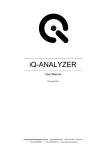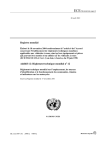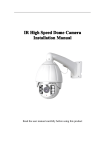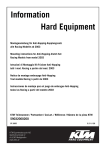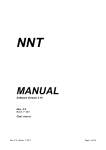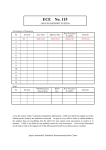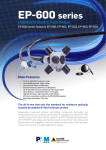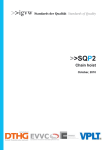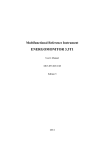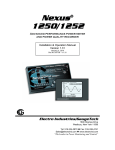Download Proposal for amendments to ECE/TRANS/WP.29/GRSG/2015/2 UN
Transcript
Submitted by the Informal Group on CameraMonitor System (IGCMS-II) Informal document GRSG-108-21 (108th GRSG, 4 – 8 May 2015, agenda item 4) Proposal for amendments to ECE/TRANS/WP.29/GRSG/2015/2 UN Regulation No. 46 (Devices for indirect vision) The text reproduced below has been prepared by the informal group IGCMS-II for amending its proposal ECE/TRANS/WP.29/GRSG/2015/2 to incorporate amendments agreed upon at its 8th meeting. The modifications to the current text of ECE/TRANS/WP.29/GRSG/2015/2 are marked in underlined for new or double strikethrough for deleted characters. I. 1. Proposals Table of Contents and a list of Annexes, amend to read: "Contents Page 1. Scope ................................................................................................................................................. I. Devices for indirect vision 2. Definitions ...................................................................................................................................... 5 3. Application for approval ................................................................................................................... 8 4. Markings ............................................................................................................................................ 8 5. Approval ............................................................................................................................................ 8 6. Requirements ..................................................................................................................................... 9 7. Modification of the type of device for indirect vision and extension of approval............................. 19 8. Conformity of production ................................................................................................................. 20 9. Penalties for non-conformity of production ..................................................................................... 20 10. Production definitively discontinued ................................................................................................ 20 11. Names and addresses of Technical Services responsible for conducting approval tests, and of Type Approval Authorities.............................................................................. 20 II. 5 Installation of devices for indirect vision 12. Definitions ......................................................................................................................................... 21 13. Application for approval ................................................................................................................... 22 14. Approval ............................................................................................................................................ 22 15. Requirements ..................................................................................................................................... 22 16. Requirements for devices for indirect vision other than mirrors .............................................. 49 167. Modifications of the vehicle type and extension of approval .......................................................... 39 178. Conformity of production ................................................................................................................. 40 189. Penalties for non-conformity of production ..................................................................................... 40 1920. Production definitively discontinued ................................................................................................ 40 201. Names and addresses of Technical Services responsible for conducting approval tests, and of Type Approval Authorities ............................................................................ 40 Transitional provisions ...................................................................................................................... 40 212. Annexes 1 Information document for type approval of a device for indirect vision ............................................... 43 2 Information document for type approval of vehicle with respect to the installation of devices for indirect vision ......................................................................... 44 Communication concerning the approval or refusal or extension or withdrawal of approval or production definitively discontinued of a type of device for indirect vision, pursuant to Regulation No. 46 ................................................................................................................ 46 Communication concerning the approval or refusal or extension or withdrawal of approval or production definitively discontinued of a type of vehicle with regard to the mounting of devices for indirect vision, pursuant to Regulation No. 46 .................................... 48 Appendix ................................................................................................................................................... 49 5 Arrangement of approval mark for a device for indirect vision .............................................................. 50 6 Test method for determining reflectivity ................................................................................................ 51 7 Procedure for determining the radius of curvature "r" of the reflecting surface of a mirror……………. 57 8 Procedure for determining the "H" point and the actual torso angle for seating positions in motor vehicles ..................................................................................................................................... 59 Appendix 1 - Description of the three-dimensional "H" point machine (3-D H machine) ..................... 59 Appendix 2 - Three-dimensional reference system.................................................................................. 59 Appendix 3 - Reference data concerning seating positions ..................................................................... 59 9 (Reserved) ............................................................................................................................................... 60 10 Calculation of the detection distance ...................................................................................................... 61 11 Determination of the displayed object size .............................................................................................. 64 12 Test methods and safety provisions for CMS of Class I to IV ..………………………....……............. nn" 3 4 2. Insert a new paragraph 2.1.13., to read: "2.1.13. 3. Paragraph 2.2., amend to read: "2.2. 4. "Type of device for indirect vision" means devices that do not differ on the following essential characteristics: (a) Design of the device inclusive, if pertinent, the attachment to the bodywork; (b) In case of mirrors the class, the shape, the dimensions and radius of curvature of the mirror's reflecting surface; (c) In case of camera-monitor systems devices, the class, the detection distance and the range of vision field of view, the magnification and resolution." Paragraph 6.2.1.3., amend to read: "6.2.1.3. 5. Mirror and CMS dual function system" means a CMS of Class I in which a monitor complying with this regulation is placed behind a semi-transparent mirror complying with this regulation. The monitor is visible in the CMS mode." The effectiveness of the CMS of classes I to IV shall not be adversely affected by magnetic or electrical fields. This shall be demonstrated by compliance with the technical requirements of Regulation No. 10, 05 04 series of amendments." Paragraph 6.2.2., amend to read: "6.2.2. Camera-monitor systems devices for indirect vision The requirements of paragraph 6.2.2.1. shall be considered to be satisfied in the case of monitors of a vehicle type-approved according to that fulfills the provisions of Regulation No. 21." 6. Paragraph 6.2.2.1.1., amend to read: "6.2.2.1.1. When the devices of the camera-monitor device system for indirect vision is are mounted on a plane surface in the intended installation position recommended by the manufacturer for normal driving, all parts, irrespective of the adjustment position of the device which are in potential, static contact with a sphere either 165 mm in diameter in the case of a CMS or parts of CMS installed inside the vehicle monitor or 100 mm in diameter in the case of a CMS or parts of CMS installed outside the vehicle camera, shall have a radius of curvature "c" of not less than 2.5 mm.." 7. Paragraph 6.2.2.3.2., amend to read: "6.2.2.3.2. Operating readiness (System availability) It shall be indicated If the system is not operational (e.g. CMS failure by i.e. warning indication, display information, absence of status indicator), it shall be indicated to the driver by i.e. warning indication, display information, absence of status indicator. The information indicated shall be explained in the operator’s manual. The operator's manual shall explain the information indicated." 8. Paragraph 6.2.2.3.3.1., amend to read: "6.2.2.3.3.1. Monitor isotropy The monitor shall conform to optical requirements over the a relevant range of viewing directions that is specified in the following paragraphs." 9. Paragraph 6.2.2.3.3.2., amend to read: "6.2.2.3.3.2. Luminance and contrast rendering For luminance and contrast rendering the following requirements shall apply: (a) The minimum luminance contrast at the monitor (including any screen protector) reproducing a high contrast pattern shall be: (i) for direct sunlight condition: 2:1 (ii) for day condition with diffuse ambient light: 3:1 (iii) for sunset condition: 2:1 (iv) for night condition: 10:1 except in case of Mirror and CMS dual function system of class I: 5:1 (b) unchanged (c) The background luminance of the monitor shall be limited under the night condition. Depending on the installation of the monitor inside the vehicle this will reduce disruptive reflections on the windscreen or other window panes. The maximum background luminance under the night condition shall be less than 2.0 cd/m², (d) unchanged." 10. Paragraph 6.2.2.3.3.2.1, amend to read: "6.2.2.3.3.2.1. Day condition with diffuse sky-light exposure test For the day condition with diffuse sky-light exposure, the test method given in ISO 16505:2015, subclause 7.8.2., Test 2 shall be applied, but the a value of 4,000 to 4,200 cd/m² for luminance diffuse illuminator shall be used replaced by 4,200 cd/m2. At the request of the manufacturer, the value for luminance diffuse illuminator may be determined by using the diagram of figure below. Ratio of projected area vs. luminance of the diffuse illuminator This value may be reduced at the request of the manufacturer under the following conditions Procedure for determining the ratio of the projected area leaving the vehicle: (a) … (b) … … Determine the luminance value that may be used by using the diagram shown in the figure below. Case when the orientation of the Mirror and CMS dual function system of class I is adjustable: Based on virtual testing, if the applicant demonstrates that the Mirror and CMS dual function system of class I adjustment range permits a driver to avoid any incident specular light from the vehicle opening while a driver’s eye is within any fixed position of the standard isotropy range, then the value for luminance diffuse illuminator shall be the one of ISO 16505:2015 subclause 7.8.2., Test 2: 1,300 to 1,500 cd/m²." 11. Paragraph 6.2.2.3.3.5.1., amend to read: "6.2.2.3.3.5.1. Smear Smear causes partial occlusion of the field of view and of the objects. Smear shall be transparent and not be more than 10 per cent of the maximum luminance value of the displayed glare source luminance level, which causes smear effect. This performance shall be tested according to the method given in ISO 16505:2015, subclause 7.8.2, Test 4.1." 12. Paragraph 6.2.2.3.3.5.2., amend to read: "6.2.2.3.3.5.2. Blooming and lens flare Blooming and lens flare are camera artefacts that cause partial occlusion of objects within the field of view. The total area of disturbance disturbing blooming and lens flare areas shall not cover more than 25 per cent of the displayed camera image. This performance shall be tested according to the method given in ISO 16505:2015, subclause 7.8.2., Test 4.2." 13. Paragraph 6.2.2.3.3.5.3., amend to read: "6.2.2.3.3.5.3. Point light sources For safety reasons, The CMS shall have an operation mode in which the driver of the vehicle equipped with CMS can recognize two point light sources (e.g. passing beam headlights) rendered as two distinguishable separate point light sources." 14. Paragraph 6.2.2.3.3.6.1., amend to read: "6.2.2.3.3.6.1. Sharpness Sharper images enable faster perception of the content shown in an image. The sharpness is represented by the MTF50(1:1) and it shall satisfy: (a) Horizontal and vertical MTF50(1:1) at center MTF 501:1 1 MTF10 MIN 1:1 LW / PH 2 (b) Horizontal and vertical MTF50(1:1) at corners (70 per cent of image height) 1 1 MTF 501:1 MTF10MIN 1:1 LW / PH " 2 2 15. Paragraph 6.2.2.3.3.6.2., delete the note that reads: Note: The main focus of the depth of field evaluation is to measure the CMS capability to recognize objects at any distance within the required field of view. As objects at nearer distances are displayed larger, the requirement at those distances can be reduced. 16. Paragraph 6.2.2.3.3.8.1., amend to read: "6.2.2.3.3.8.1. Flicker The entire image area of the monitor shall be free of flicker for at least 90 per cent of the user population according to For the flicker determination, the test method of Annex 12, paragraph 1.2. shall be applied." 17. Paragraph 6.2.2.3.4.1., amend to read: "6.2.2.3.4.1. Frame rate Movements of objects in front of the camera shall be rendered smooth and fluid. The minimum frame rate of the system (update rate of the image information) shall be at least 30 Hz. At low light conditions or while manoeuvring at low speed, the minimum frame rate of the system (i.e. update rate of the image information) may drop (e.g. due to longer exposure times or image processing) but shall be at least 15 Hz." 18. Paragraph 6.3., amend to read "6.3. Test The requirements of paragraph 6.3. shall be considered to be satisfied in the case of monitors of a vehicle type approved under fulfilling the provisions of Regulation No. 21." 19. Paragraph 6.3.2.2.4., amend to read: "6.3.2.2.4. 20. In case of camera-monitor systems, when the pendulum is in a vertical position the horizontal and longitudinal vertical planes passing through the center of the hammer shall pass through the center of the lens or of the transparent protection part protecting in front of the lens. The longitudinal direction of oscillation of the pendulum shall be parallel to the longitudinal median plane of the vehicle. If the test is performed with a shutter camera system, the shutter has to be open during the pendulum impact." Paragraph 15.2.4.5.13., amend to read: "15.2.4.5.13. Paragraphs 15.2.4.5.6. to 15.2.4.5.12. above shall not apply to a vehicle where any part of the a Class V mirror, if fitted, or its holder, is less than 2.4 m above the ground, regardless of its position after adjustment." 21. Paragraph 16.1.1., amend to read: "16.1.1. Intended use, activation and deactivation The intended use shall be mentioned within the operator's manual. The procedure for activation and deactivation of the CMS of class II and III shall allow a safe use of the vehicle. The CMS shall be activated when the vehicle is opened (e.g. unlocking of the doors, opening of a front door or any other means by the choice of the manufacturer) and entire FOV available under specific driving conditions based on user safety needs. These driving conditions are defined by the possibility for one occupant to be present inside the vehicle or outgoing. If the actions sequence lets the opportunity for one occupant to be in this configuration, then CMS of classes II and III shall be switched on comply with the following sequence: In addition to the requirements mentioned in paragraph 15.2.1.1.2., Aafter each engine switch-off the system shall remain operational for a period of at least T1=120 seconds. After T1 period and for a period of at least T2 = 300 s (420-T1) seconds the system shall be able to be reactivated such that the required field of vision is made available within 1 second automatically by manoeuvring any front door opening and optionally and, if available, manually by the driver. After T2 period the system shall be able to be reactivated within 7 seconds by manoeuvring any front door opening and optionally manually by the driver (e.g. by initiating any front door opening process). After each system reactivation time count restarts at the beginning of T1. When the vehicle is locked, whenever this occurs after the engine is switched-off, the system may be deactivated. Notwithstanding the provisions above, any other concept to activate or deactivate the system shall be demonstrated to the satisfaction of the Technical Service within the safety concept that is provided according to the provisions in Annex 12, paragraph 2." 22. Paragraph 16.1.1.1., amend to read: "16.1.1.1. Default view In default view the CMS shall show the field of view at least as defined in paragraph 15.2.4., with at least the required magnification and resolution as defined in paragraph 16.1.3. In case of Mirror and CMS dual function system of class I, the CMS mode shall be set by the driver." 23. Annex 1, insert a new item 6.1., to read: "6.1. Other mean of identification link to the approval mark: ……………………….." 24. Annex 12, the title, amend to read: "PROVISIONS RELATING TO TEST METHODS AND SAFETY PROVISIONS FOR CMS OF CLASS I TO IV" 25. Annex 12, paragraph 1.2., amend to read: "1.2. Flicker test The entire image area of the monitor shall be free of flicker for at least 90 per cent of the user population. The flicker evaluation uses the determination given in Annex B of ISO13406-2: 2001. The following measurement procedure applies:" 26. Justification item 30, amend to read: 30. Paragraph 6.2.2.3.3.5.2., blooming and lens flare Blooming and lens flare are camera artefacts that cause partial occlusion of objects within the field of view. The blooming and lens flare provisions are a copy of the text provided by ISO 16505:2015, and this provision restrict the amount of the maximum allowance of the light expansion when a highlight illumination hits within the CMS field of vision………… optical lens flare. " 27. Justification item 32, amend to read. 32. Paragraph 6.2.2.3.3.6., sharpness and depth of field The provisions on "Sharpness and depth of field" are from ISO 16505:2015, and the sharpness provision aims to verify that the system has enough image contrast reproducibility, which is essential to rapid perceptibility of the scene; and the provision on depth of field to secure that observed scene within the target distance are well focused and not blurred and defocused. Sharp images enable faster perception of the content shown in an image. 28. Justification item 67, delete paragraph that reads "67. Paragraph 16.1.8., influence of weather As there are no specific requirements on the protection of mirrors against influences of the environment such requirements will also not be given for CMS. Nevertheless, the user's manual shall provide cleaning instructions." 29. Justification item 68, replace the reference to paragraph 16.1.9 by "paragraph 16.1.8." II. Justifications Contents, Annexes The contents of the Regulation and the list of Annexes have been re-introduced as they were unintentionally not included in document ECE/TRANS/WP.29/GRSG/2015/2. In addition, the title of the new Annex 12 has been corrected. Paragraph 2.1.13. Definition of "Mirror and CMS dual function system" was added to cover the content of revised paragraph 6.2.2.3.3.2. and 6.2.2.3.3.2.1. Such a system is limited to Class I. Paragraph 2.2. For camera-monitor systems, defining the type based on the class only, allows all kind of systems with completely different performances to be considered as of one and the same type. To bring the type definition for camera-monitor systems in line with the intention of a type definition in general and, in particular in line with the description already existing for types of mirrors (2.2.(b)), the above is proposed. Paragraph 6.2.1.3 The preceding series 04 of amendments are also applicable. This prevents the requirement for rehomologation for vehicles with existing homologation of this series. Paragraph 6.2.2. The former wording required that the technical provisions of Regulation No. 21 have to be met, but we do not require an official approval certificate. This is a standard approach for a reference to other regulations in many regulations. Plus now the formulation meets the target as explained in the justifications, and is aligned on the guidelines (ECE/TRANS/WP.29/1044/Rev.1). Paragraph 6.2.2.1.1. The intended installation has been replaced by a more defined description. Normal driving position is defined in paragraph 15.2.2.1. Paragraph 6.2.2.3.2 The important factor is to inform the driver and not anybody. Paragraph 6.2.2.3.3.1. "Relevant" is explained in the following paragraphs. Paragraph 6.2.2.3.3.5.1. The first sentence is a description of Smear and it is described in the justification. The sentence is therefore deleted. Paragraph 6.2.2.3.3.5.2. The first sentence is a description of Blooming and lens flare which is described in the justification. The sentence is therefore deleted. Paragraph 6.2.2.3.3.5.3. The majority of the provisions in the Regulation N°46 are about safety and it is not particular to this paragraph item. The header of the sentence is therefore deleted. Paragraph 6.2.2.3.3.5.6.1 The whole sentence moved into the justification as this is only descriptive. Paragraph 6.2.2.3.3.6.2 The entire Note has been deleted to avoid confusion with requirement while content is just explanatory. Paragraph 6.2.2.3.3.8.1 Flicker test as described in the Annex 12 paragraph 1.2.1. follows the procedure as determined in the ISO13406-2: 2001, which considers as cut-off definition "The image shall be free of flicker to at least 90 % of the user population." Paragraph 6.3. The former wording required that the technical provisions of Regulation No. 21 had to be met, but an official approval certificate is not required. This is a standard approach for a reference to other regulations in many regulations. Now the formulation meets the target, and is aligned on the guidelines (WP29/1044/Rev.1). Paragraph 16.1.1 The activation and deactivation from CMS are defined in a general manner for most of the use cases. But there might be other specific cases. For examples: cases in which there will be no occupants once a vehicle is locked from outside, or where no CMS is required being in a safe parking environment. Different manner of activation and deactivation may then be suitable and Technical Service shall check the safety concept of these different cases. Paragraph 16.1.1.1. Case of Mirror and CMS dual function system is introduced clarifying that the driver must select the CMS mode. Paragraph 16.1.8 The paragraph in the main text has been deleted, so its justification is deleted accordingly. Renumbering of paragraphs is needed. Paragraph 15.2.4.5.13 The present exemption for vehicles of which the class V mirror is fitted below 2.4 meter, is based on the technical incompatibility to meet the provisions for the extended field of vision on the driver's side. As such an incompatibility does not exist for a CMS the informal group proposes to limit that exemption to mirrors. Paragraph 2.1.13., 6.2.2.3.3.2., 6.2.2.3.3.2.1., 16.1.1.1.… Mirror and CMS dual function system of class I is introduced, considering that the system shall satisfy each of the requirement when independently operated. The definition is introduced as a new paragraph 2.1.13. In this system, Mirror and CMS dual function system may fully operate as conventional mirror of class I when monitor is not in operation. When the CMS monitor mounted beneath the mirror is operated with appropriate adjustment, it provides field of vision as per CMS. This enables the driver to keep the benefit of a mirror regulated under Regulation No.46 as today, and in addition use a CMS that provides the benefit of this technology whenever the driver wants. The driver is ensured to have the possibility to go back to the mirror mode if for any reason he/she does not feel comfortable with the CMS. This could be for example the case in a convertible vehicle when used without the soft top. The Mirror and CMS dual function system might ease the acceptance of the CMS by experienced drivers and thus the introduction of the CMS technology on the market. Including a mirror function, the Mirror and CMS Dual function system must be adjustable (existing requirement of 2.1.1.1). This particular provision is taken into account as an asset for the driver to adapt the orientation of CMS so that: only the standard isotropy range shall be considered the mirrored pyramid of the standard isotropy range may be oriented in a direction where it does not get out of the vehicle. Doing this the driver can avoid any discomfort or disturbing glare, thus decreases the need for testing with high luminance values. Night condition contrast of 5:1 was the original requirement of the ISO16505 with the recommendation of 10:1 in consideration of possible human eye night performance alteration. Within the Mirror and CMS Dual Function system, any driver can switch back to mirror at night or at any time, as easily as he/she does it today with a day-night mirror, and the extreme cases may not be considered. Descriptive sections of paragraph 6.2.2.3.3.2 and 16.1.1 have been removed. ______________________









